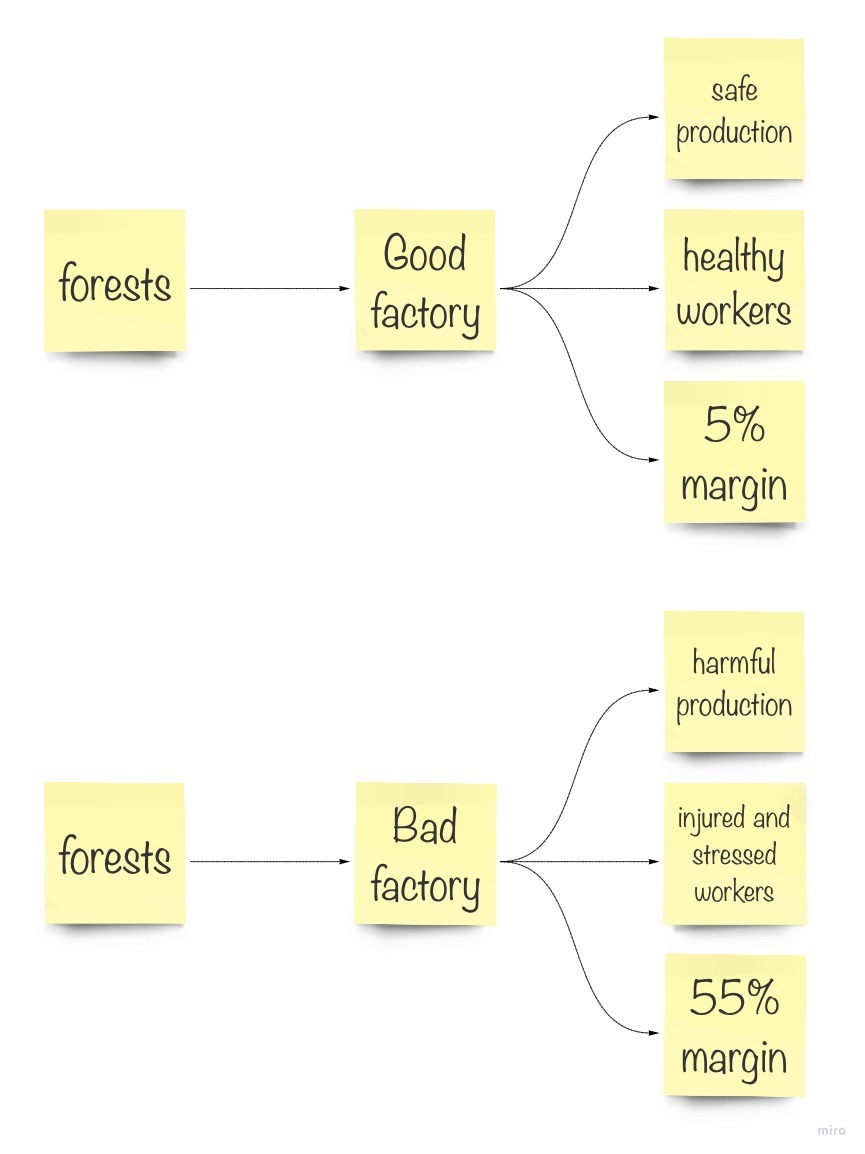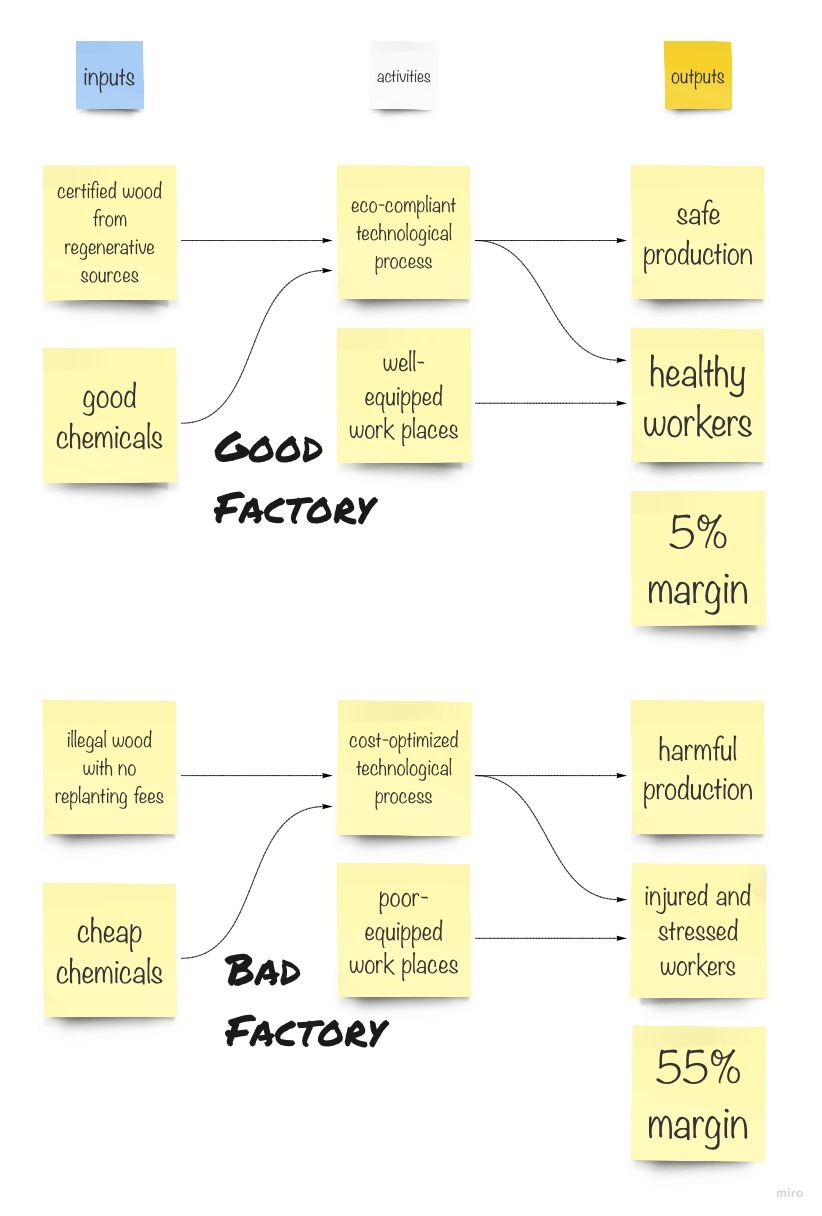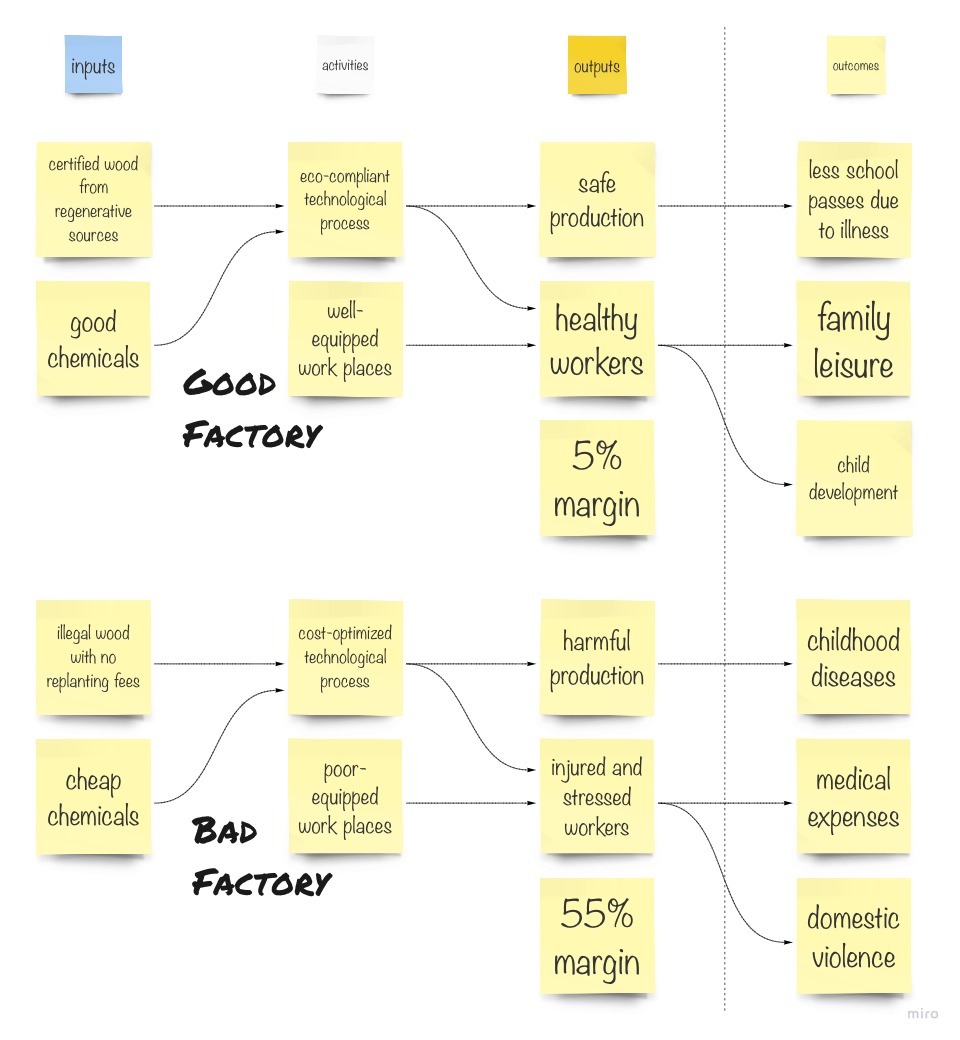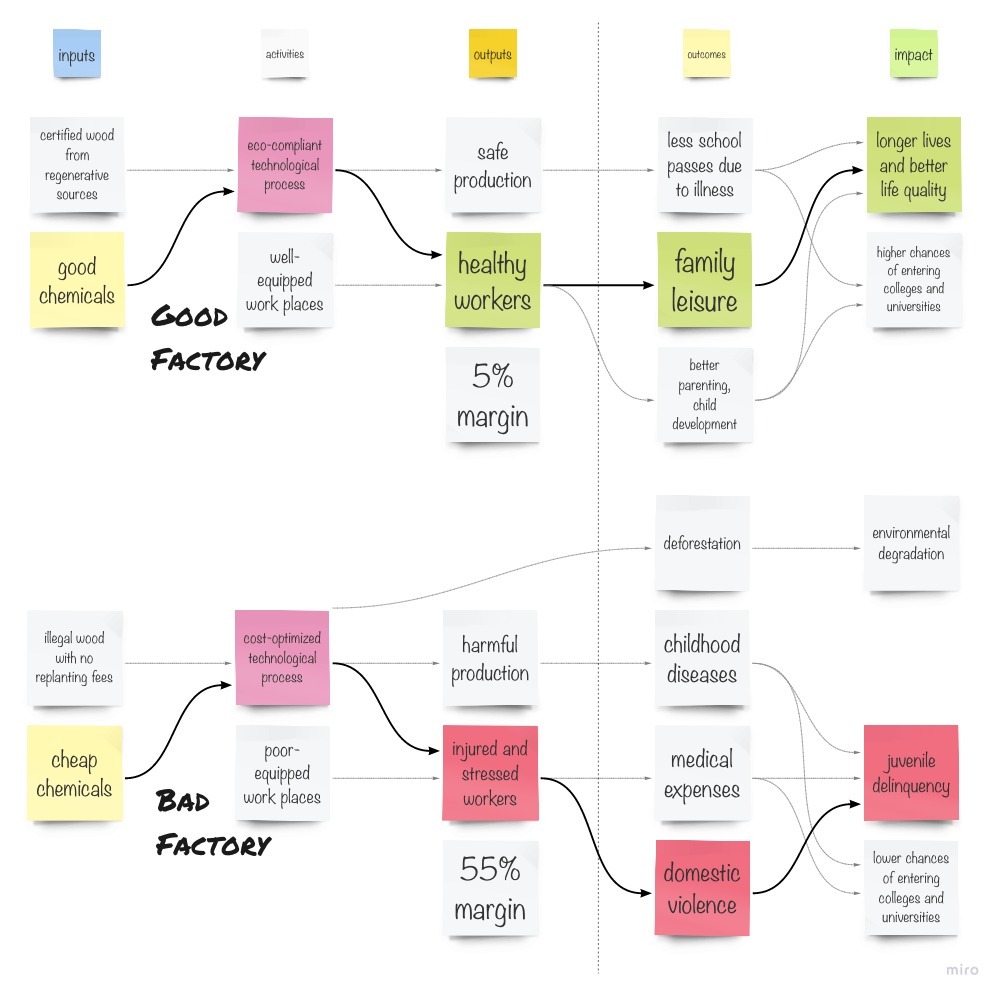We know a lot of chains: supply chains, value chains, responsibility and decision chains, chains of events… This term and logic feels natural for us. There is a strong foundation for this—we live in the universe with causation effects. This means if we do something, it will lead to some consequences. If something happened, there were definitely some causes or reasons for that.
The same is for impact. In the Impact in a nutshell article we looked at an example of how one furniture factory can ruin two neighboring towns. Today we will build the logic of an impact chain.
And the first thing we should admit—impact is a consequence of our own previous actions.
So what we had in that example. There are:
- two factories with production lines. And some people work there.
- forests around which are sources for the wooden furniture production.
- poisonous varnishing chemicals and bad working conditions.
- Bad’s cost cuts that made Good factory unprofitable.
- towns which become slums in the middle of wastelands in several decades.
This looks quite simple, but even with less than 10 elements it becomes hard to keep this all in mind. So let’s draw a scheme.

Now it’s more clearly visible, what is going on. And we can say we see three logical layers from left to right:
- Some resources or inputs,
- Some activities,
- Some direct results or products.
We also do not see enough details in difference between Good and Bad one, so let’s add some here, we already know.

Okay… looks close to what we want to depict. Now we see how exactly they produced those quite similarly looked products but with very different results. Also we have discussed previously how these results went outside factories’ walls when people got back to homes, remember? That some of them were playing with their children in a great mood, when others went to clinics to get proper treatment. Let’s add the next layer to the right.

The scheme becomes quite complex. I added a dotted line which marks a factory’s boundary.
Usually companies say here: “life is hard, we know about stressful situations and all those diseases outside and so on. But we can be responsible only for our territory… and yes, our process is a trade secret, so please show your permission to come in”.
And people who have such permission will keep silent not to be fired and sued for divulging trade secrets. So, as we will see many many times, this dotted line is a very important element in impact schemes.
Now it’s time for an impact to appear on our scheme. I am still using our example from Impact in a nutshell, so if you feel a little lost, keep it open. I am also adding some new markup to make the impact graph more informative.

Here it is. I must say right away how to understand the colors:
- Yellow post-its are neutral to people (even bad chemicals and poor-equipped workplaces are not bad by itselves, but have negative consequences then).
- Green ones are positive to people.
- Reds are negative.
- Pink are the points of critical decisions.
I realize that this scheme is incomplete and inaccurate. For example, Bad factory can lower the prices and make products affordable for more people. And get some positive impacts by that like providing better conditions for underserved people. But this exercise’s main goal is to make the picture clear and simple to understand. To have something to compare, I’ll propose a text version of it below. But let’s finish our main goal here first—to understand where does an impact come from and how is it produced. And what impact-chain is.
If we highlight the logical sequences on the scheme we will see the lines which can be described as complete sentences. Let’s see on the following two and read them:

Good: “They use only good chemicals in their eco-compliant technological process to save their employees health. This lets employees save time on medical treatment and spend more time with their kids which, they believe, will lead them all to longer lives and better quality of life”.
Bad: “They use the cheapest chemicals to optimize the cost of their technological process, and they take risks for workers to be injured. Stress and health harm push workers to be more aggressive and violent with their relatives which leads to more unhappy kids and juvenile delinquency in the town”.
This is what we call impact chain, or impact line. And we can analyze it in the same manner as any other chains: follow causations, seek for the weakest link, analyze decision management around them and suggest consequences. Now we see how different chemicals production relates to crime and quality of life through a certain intermediate management.
Another one very important conclusion of a chain-like nature of impact—all parts are contributing to the final impact: suppliers, producers, employees and consumers. Thus impact is produced on each stage of the chain, not only in the end of it!
There is no one who is guilty alone for the whole impact, no matter bad or good. It is always a chain, and we all are some parts of many of such impact chains. In some we are buyers, in others we are producers. And pretty no one of existing impact-chains appeared by themselves.
Now you can apply this approach to analyze your product, service or a whole company and outline your major impacts. You can also use this logic to analyze products and services you use to imagine your impact as a buyer.
Appendix: Text versions of the impact schemes
Here we try to let you feel the difference between impact graphs (our schemes from above) and usual plain text descriptions of companies’ impact. So that every time you read the report the next time, you ask yourself: “Why don't these guys just draw a simple and understandable outline? Why are all these words that are so hard to keep in mind here?”
First, let’s have all the post-its simply typed downhere.
Good
- certified wood from regenerative sources
- good chemicals
- eco-compliant technological process
- well-equipped work places
- safe production
- healthy workers
- 5% margin
- less school passes due to illness
- family leisure
- better parenting, child development
- longer lives and better life quality
- higher chances of entering colleges and universities
Bad
- illegal wood with no replanting fees
- cheap chemicals
- cost-optimized technological process
- poor-equipped work places
- harmful production
- injured and stressed workers
- 55% margin
- childhood diseases
- medical expenses
- domestic violence
- juvenile delinquency
- lower chances of entering colleges and universities
- deforestation
- environmental degradation
You may compare them with schemes on this stage (which is not fair because information from arrows was not shown), but we’ll enrich the explanations.
Good: Company uses certified wood from regenerative sources and good chemicals to guarantee eco-compliant technological processes. It also cares about workers by providing well-equipped work places. Altogether these measures lead to safe production and healthy workers with overall business margin at 5%. Due to saving their health, workers spared the need to spend more time on medical treatments and health-related issues. Together with higher salaries they can afford full-fledged family leisure and devote their free time to better parenting and child development. As an impact this produces longer lives and better life quality for them and their families and higher chances of entering colleges and universities for their children.
Bad: Company uses illegal wood with no replanting fees and cheapest available chemicals to optimize costs of their technological processes. To push this farther they provide only minimally equipped workplaces and lower possible market salaries. With aggressive management they are able to produce competitive products with as high as 55% margin! Pay for that is production which can not pass ecological certifications (but local markets are not well-regulated and they are able to do business) and injured and stressed workers. This causes two lines of negative impact: social and environmental. From one side injured and stressed workers are more tended to domestic violence, and have less time due to need of additional medical treatment. They also spend their own money on them which makes them even more depressed. As a result their children have lower chances of entering colleges and universities and produce local juvenile delinquency. From another side use of illegal wood with no replanting fees leads to deforestation and broader environmental degradation.
Now just look at these two paragraphs and compare them to our graphs above.

